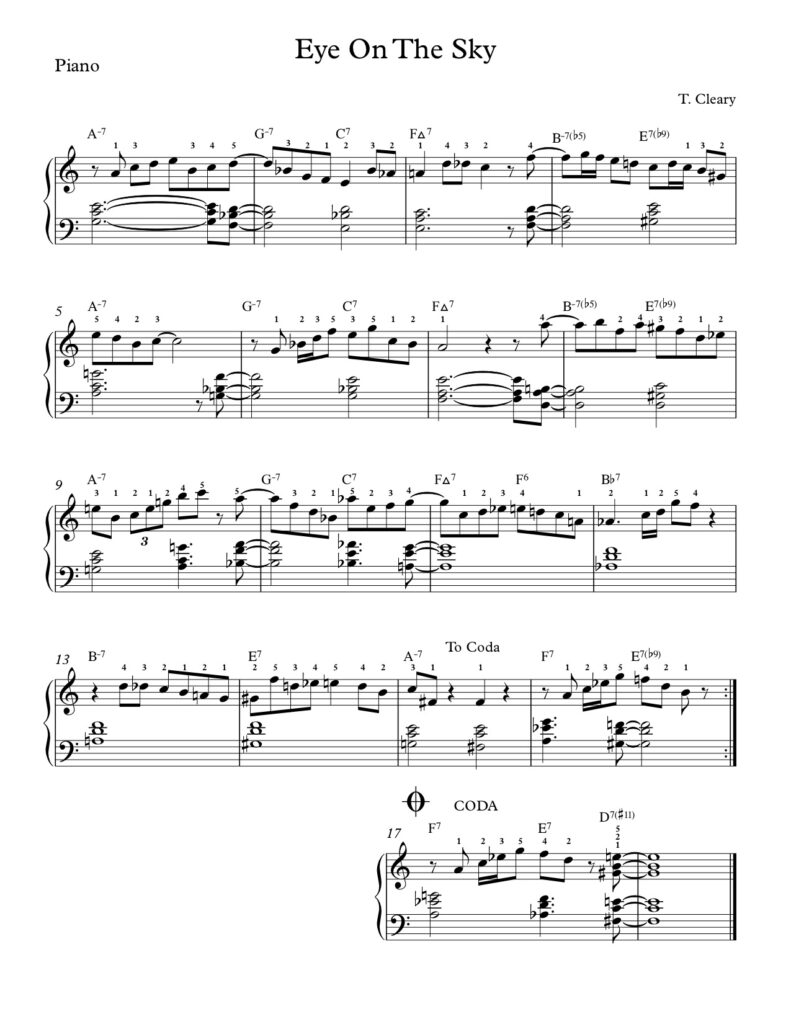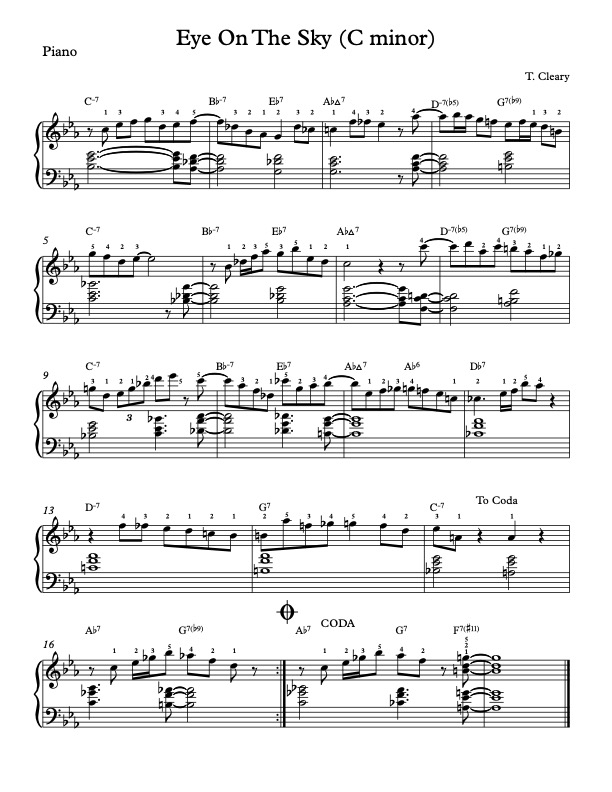I began writing this post on November 23rd, 2o19, one day after the anniversary of President John F. Kennedy’s assassination in 1963. According to an interview with composer Bobby Hebb, it was that event, as well as the murder of his own brother the following day, that led him to compose his song Sunny as an antidote to the shadow these tragedies cast over his life. ‘It was dark when I started working on the song, and the sun was rising,’ Hebb says. ‘Everybody was feeling rather negative at that time, and I think that we all needed a lift.’ Although Hebb composed the tune in 1963, and a version by the Japanese vocalist Mieko Hirota with pianist Billy Taylor was apparently recorded in 1965, Hebb himself did not record the song until 1966. Besides Hebb’s version being a major hit record, and the song being recorded by many different artists, there are many jazz and pop tunes from the following decades that appear to be built from elements of the ‘Sunny’ chord progression.
In Hebb’s original recording, the song begins with four-measure, five-chord loop (Em7-G7-Cmaj7-F#m7-B7) which is expanded into a sixteen-bar form by playing the loop twice and then following a slightly different third phrase (Em7-G7-Cmaj7-F7) with a different final phrase (F#m7-B7-Em). A version in A minor by Frank Sinatra with the Duke Ellington Orchestra (from the 1967 album ‘Francis A. and Edward K.’) expands the second chord into a ii7-bII7 progression, Gm-Gb7 (i.e. a ii-V progression with a tritone substitution for the V), and changes key only once, in contrast to the three half-step key changes in Hebb’s original.
One of the earlier songs to borrow the ‘Sunny’ progression is Freddie Hubbard’s Red Clay, recorded in 1970, in which the solos are based entirely on the first four-bar phrase of the ‘Sunny’ progression, transposed to C sharp minor but incorporating the added major ii-V progression heard on the Sinatra version.
On the album ‘Pat Martino/Live!’, recorded in 1972, the guitarist plays an extended version of ‘Sunny’ (over ten minutes) in the same key as Sinatra in which he eliminates the half-step key changes between verses heard on vocal versions. Keeping the song in a single key allows Martino and keyboardist Ron Thomas more flexibility to apply bebop melodic concepts in their extended solos. Martino has reprised this arrangement of the tune a number of times, notably in a live version from 2000 with fellow guitarist John Scofield and fellow Philadelphians organist Joey DeFrancesco and drummer Byron ‘Wookie’ Landham.
My tune ‘Eye On The Sky’, which uses the changes to ‘Sunny’, is partly inspired by Martino’s bebop approach to the tune. Downloadable charts for the tune are below, in A minor (Martino’s key for ‘Sunny’) as well as C minor and C# minor (two keys in which ‘Red Clay’ is played, the latter being the key of the original version). Here is a link to an informal solo piano recording I made of the tune in A minor. For those interested in learning to improvise on the changes and/or building their own line on the tune, I have also created a ‘chord line’ based on root position patterns from the tunes ‘Round Midnight’ and ‘I Can’t Get Started’. The melody to ‘Eye On The Sky’ is what I call a ‘voicing-based line’. I learned this concept from pianist Mike Longo’s book, The Technique of Creating Harmonic Melody for the Jazz Improviser, which shows how to build melodic lines from chord voicings that employ efficient voice leading (i.e. avoiding wide leaps and voice crossing when possible.)
On the song If You Want Me To Stay from the 1973 album Fresh, Sly and The Family Stone move one step beyond Freddie Hubbard and base an entire tune on the first four bars of the ‘Sunny’ progression. This song is somewhat remarkable for not having a chorus or refrain section and yet managing to avoid excessive repetitiveness through intricate variations on its opening four-bar melody phrase and the addition of horn lines more varied than the chord progression. (The intro to the tune includes a reference to ‘Sunny’ in the guitar part.)
Stevie Wonder recorded his own version of ‘Sunny’ (featuring a classic James Jamerson bassline) in 1968, which leads me to think he may have begun writing his 1973 song Don’t You Worry ‘Bout A Thing by expanding the third phrase of the song’s progression. Wonder extends the opening minor chord to two bars instead of one, keeps the extended chord from sounding static by adding a chromatically descending root, and adds a Latin accompaniment figure referred to alternately as montuno or guajeo. In his tune Angela, recorded in 1978 (also the theme to the TV series ‘Taxi’), Bob James bases the solo changes on an eight-bar progression in which the second four-bar phrase is nearly identical to the opening phrase of ‘Sunny’.
It seems somewhat possible that the progression for the 1980 Bill Withers/Ralph MacDonald/William Salter song Just The Two Of Us might have been devised by halving (i.e. speeding up) the harmonic rhythm of the first phrase of Sunny, so that it lasted only two bars instead of four, and then reversing the order of the two bars. Even if this is not how the song was conceived, it is what I call a useful ‘creation myth’ – an origin story which can help one notice a resemblance between the two progressions, which can in turn help with memorizing the two songs. Bassist Christian McBride recorded a version of this tune with his band Philadelphia Experiment, including a solo which is a great example of using bebop language in a funk context. (Thanks to Lara Cwass for recommending this version to me.)
In her 2013 song Electric Lady, Janelle Monae moves one step beyond Sly and the Family Stone, basing an entire song on the first four measures of the ‘Sunny’ progression, but creating two distinct melodies, a lower-pitched line for the verse and a higher-pitched line for the chorus. It is an impressive display of the composition skills of Monae and her collaborators that they manage to create a chorus which uses the same chord structure as the verse and yet remains distinctive through its melody and orchestration alone.
Finally, Ariana Grande’s 2018 song Thank U, Next also has a chorus which uses the same chord structure as the verse, but in this song it is variation in melody and bassline which distinguishes the chorus from the verse. The chord progression from the chorus stretches the chord progression of ‘Just The Two Of Us’ from two bars to four, and the verse uses a clever variation on the bass notes from the older song’s progression. While none of the composers of ‘Thank U, Next’ have said they were consciously borrowing from ‘Just The Two Of Us’, there is an ironic appropriateness in a break-up song (albeit an upbeat one) having a similarity to an older song that is an anthem of a couple’s commitment to each other. (Thanks to Sam Mark for recommending this song and pointing out its relationship to ‘Just The Two of Us’.)



I’d always jammed from Red Clay into If You want me to stay and would just hang in the same key as we were playing red clay in, but I never noticed how direct the relationship between these two tunes and Don’t you worry bout a thing was, all three or them being based on the same source material to some degree. And it’s really interesting to hear the Janelle Monae tune while now thinking about that this relationship as well.
Nice post! I’m learning eye on the sky right now, and have been working on sunny for a while- they are really nice changes to improvise over. I had no idea the sunny progression had been used so many times in such popular songs- guess you learn something every day.
Personally I agree with Pat Martino’s decision to take out the key changes between the verse and chorus; not sure what it adds to the composition. Sure, there is a bit of added tension, but the technique is used quite early in the song, which means to keep interest there has to be another key change, and another. For me it doesn’t quite work. Harmonically the foundation of the song is great, especially for the genre of the original. Fun to solo over for sure.
Most interesting !
I think that Marc Robertson uses the same chord structure in “Bounce” ‘s chorus :
https://youtu.be/AKRibWtkaM8?t=76
Djavan’s “Samurai” chords are related too :
https://youtu.be/qi5KhD9utfw
(It features Stevie Wonder on harmonica !)
The link to Janelle Monae’s Electric Lady doesn’t work anymore ; this one does : https://www.youtube.com/watch?v=LPFgBCUBMYk
It’s interesting how pervasive this chord progression has really become. I had no idea artists like Janelle Monae and Ariana Grande had songs based off this progression. When I first sat down to learn this piece, I instantly recognized the tune. I’m pretty sure I’ve heard this song sampled in several hip hop songs too, but I can’t remember what those songs are called. It’s crazy that I know I have heard this melody and progression several times in the past, yet I had no idea who Bobby Hebb was or what the original song was named.
It’s amazing how one chord progression can keep itself in the rotation for so many decades. After learning how to play ‘Sunny,’ I can see why. The chords and melody have a quality that evoke a specific emotion, and I think it’s this emotional quality that has kept this chord progression popular. I also connected to what was said in the first paragraph about Hebb writing this song from a place of darkness. Music can be an amazing tool to get through hard times.
Wow. It’s crazy to think of how all these pieces across almost 50 years might be building off of one another. I often think about how music composition seems to sometimes be a process of remixing instead of creating from scratch. An artist such as Stevie Wonder who has created so many instant classics and recognizable original works certainly cannot be creating in a vacuum. Looking further into it, I found it interesting that this piece is known as one of the “most recorded” pop songs from 20th century. I appreciate how each new artist to record the work would add their own alterations and ‘flavor’ to it such as Wonder’s extension of the first chord or Sinatra and Ellington adding a major ii-V progression.
This type of recreation that was happening in the 60’s/70’s/80’s I think definitely still exists today across the board, but simpler, more exact ‘copy’ covers are becoming much more common in the genre of popular music. I will often hear a new cover and not find it at all interesting because there is no difference musically between it and the original song. One genre today that is always expanding the methods of recreating its own music in my opinion is contemporary hip hop. Though a bit far removed from 70’s R&B, this genre is constantly replicating, modifying, and shuffling the music that it produces while also sampling motifs, melodies, and phrases from essentially any other genres (including 70’s R&B). Your article’s description of “Sunny” ‘s journey between artists, genres, and decades brought to mind many examples of tunes used by contemporary hip hop artists that have had similar journeys.
Read more about “Sunny” as one of the most recorded songs for several decades: https://www.independent.co.uk/news/obituaries/bobby-hebb-singersongwriter-whose-hit-single-sunny-became-one-of-the-mostcovered-songs-of-all-time-2044608.html
Read more about “Sunny” as one of the most recorded songs of all time:
https://stacker.com/music/most-covered-songs-all-time
See “Sunny” on BMI’s Top 100 Songs of the Century” list:
https://www.bmi.com/news/entry/19991214_bmi_announces_top_100_songs_of_the_century
Watch contemporary pop artist Billie Eillish perform “Sunny” :
https://www.youtube.com/watch?v=IJuHn8JzhP0